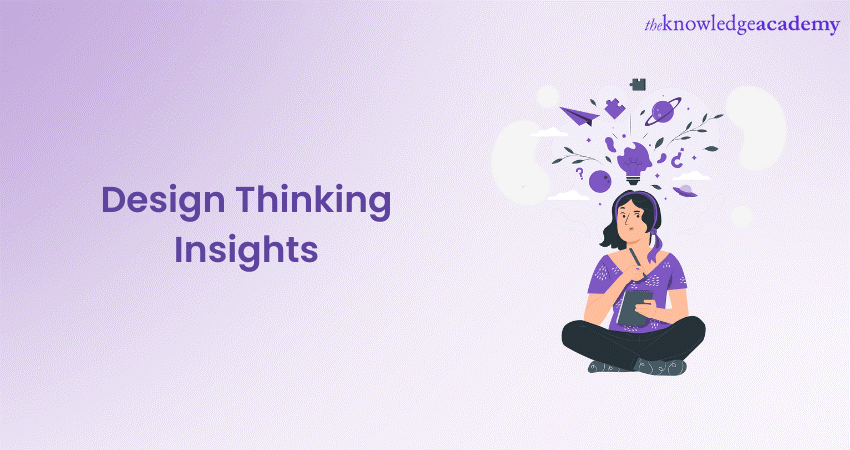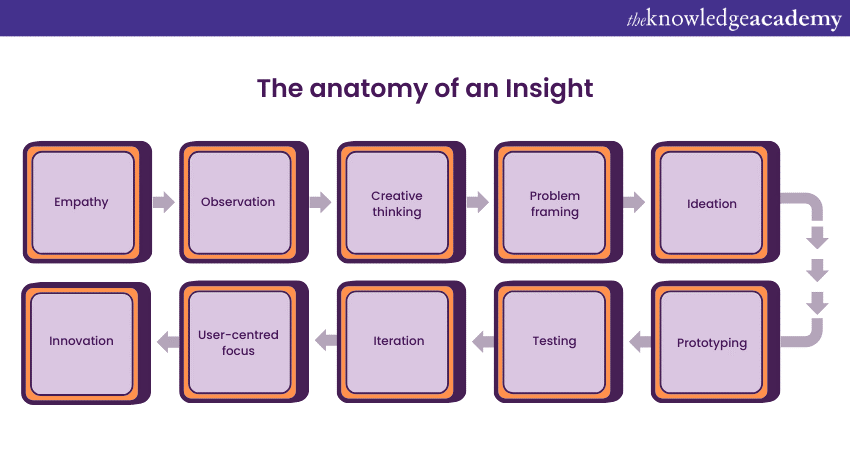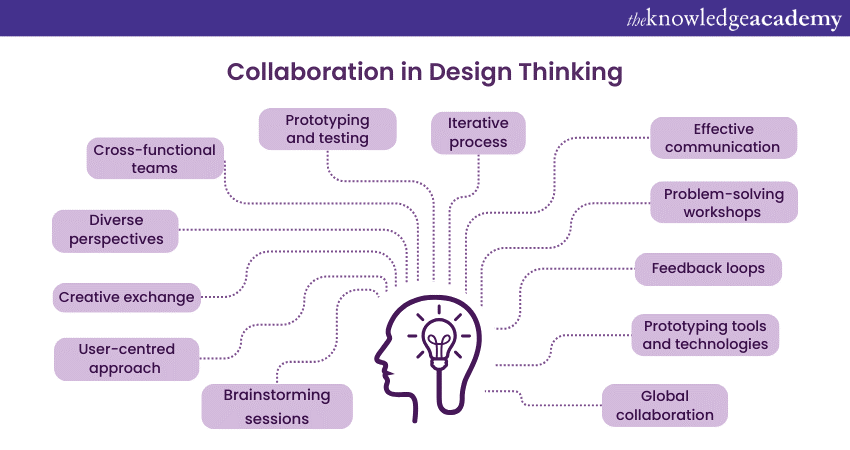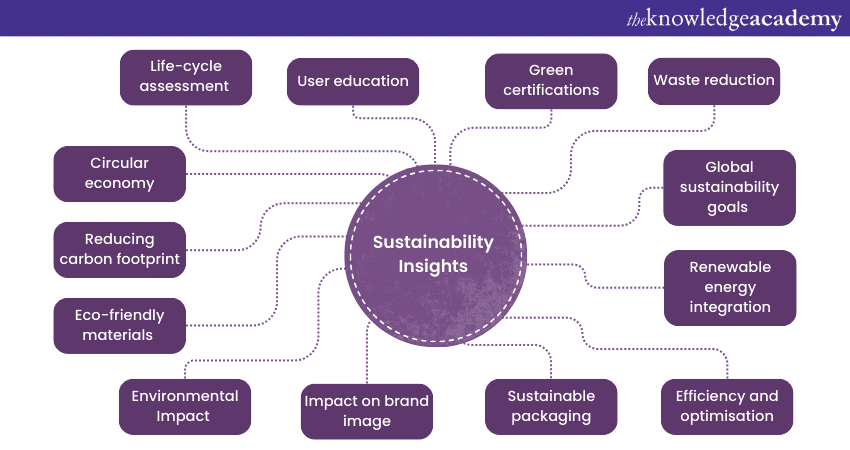We may not have the course you’re looking for. If you enquire or give us a call on + 1-866 272 8822 and speak to our training experts, we may still be able to help with your training requirements.
Training Outcomes Within Your Budget!
We ensure quality, budget-alignment, and timely delivery by our expert instructors.

Design Thinking is a problem-solving approach that has gained immense popularity in recent years for its human-centric and innovative solutions. At the heart of this methodology lies the concept of Design Thinking Insights. In this blog, we will explore what Design Thinking Insights are, why they are crucial, and provide real-life Design Thinking Insights examples to illustrate their significance. Read this blog on Design Thinking Insights and explore how it strikes the ideal balance between analysis and imagination for effective problem solving.
Table of Contents
1) What is Design Thinking?
2) What is an Insight in Design Thinking?
3) How to improve insight generation with Design Thinking?
4) Design Thinking Insights examples
5) The power of Design Thinking Insights
6) The evolution of Design Thinking Insights
7) Conclusion
What is Design Thinking?

Before delving into the world of Design Thinking Insights, let's establish a solid understanding of what Design Thinking is. At its core, Design Thinking is a creative and empathetic problem-solving process that puts people at the centre of the innovation journey. It consists of a series of structured steps, often depicted as a circular process, which typically include empathising, defining the problem, ideating, prototyping, and testing.

What is an insight in Design Thinking?
Now that we have a basic grasp of Design Thinking, let's explore the concept of an insight in Design Thinking. An insight in this context is a deep, often unexpected, understanding of a problem or a user's needs and motivations. Insights are the jewels of the Design Thinking process. They serve as the foundation upon which innovative solutions are built.

Design Thinking Insights go beyond surface-level observations and provide a profound understanding of the issues at hand. These insights can arise from various sources, including user interviews, observations, data analysis, and brainstorming sessions. The ability to uncover meaningful insights is what sets Design Thinking apart as a problem-solving approach.
The role of insights in Design Thinking
Insights play a pivotal role in every stage of the Design Thinking process. Here's how they contribute to the overall success of Design Thinking:
1) Empathy building: In the empathising phase, design thinkers seek to understand the user's perspective deeply. Insights gained during this phase enable Designers to connect with users on a more profound level, fostering empathy and a genuine understanding of their needs and challenges.
2) Problem framing: Insights help in defining the problem accurately. When Designers have a clear understanding of the underlying issues, they can formulate more targeted and effective problem statements.
3) Ideation and innovation: During the ideation phase, insights serve as a wellspring of inspiration. They provide Designers with a rich pool of ideas and concepts to explore, leading to more innovative and user-centric solutions.
4) Prototyping and testing: Insights guide the creation of prototypes by ensuring that they address the identified pain points and user needs. Testing these prototypes with users helps refine the design and verify its effectiveness.
5) Iterative process: Design Thinking is an iterative process, and insights are continually refined and updated as new information emerges. This iterative approach ensures that the final solution is continually improved and refined based on user feedback.
How to improve insight generation with Design Thinking?
Design Thinking is a creative and user-centred approach to problem-solving that can help design teams generate better insights. Here are five ways to apply Design Thinking to insight generation:
Step 1: Be a detective
Instead of relying only on data sources like datasets, reports, charts, emails or forms, insight teams should interact with the people involved in the challenge they are working on. It could include their colleagues, decision makers, experts, or data providers in their organisation.
They should also observe their customers or consumers and how they use their organisation’s process or product. They should be curious, open-minded, and attentive when they do. They should ask questions and listen carefully. It can help them discover the root causes, the hidden truths, the assumptions, the biases, and the key insights of the challenge.
Step 2: Visualise
As they collect and analyse their data, insight teams should try to visualise it in a way that makes sense. They can think of how detectives create a wall of evidence – maps, photos, notes, and strings showing the connections.
Visualising data can help them in many ways. It can enhance their cognitive abilities and help them make new connections and see patterns. It can also help everyone involved to see the big picture (and their role in it). It can help them in identifying opportunities for improvement.
Step 3: Build empathy
Many people in organisations have little or no contact with their customers or consumers. There can also be a lack of understanding between different teams and departments within organisations.
It can lead to misconceptions and stereotypes that are not based on real experiences. A lack of contact with their end users can also make them waste time guessing what they would do or want, or worse, what they would want.
By talking and observing their end users and sharing the results with everyone involved, insight teams can help build empathy.
Step 4: Prototyping
Designers of new products know that the best way to test their ideas and get feedback is to use prototypes. It’s much more effective than just talking about a theoretical concept. Prototypes are also used in research, and virtual reality makes this process cheaper and easier. For example, hotel groups use this technology to see how consumers react to new room designs.
Insight teams can apply this ‘fail fast’ approach to how they generate new insights in their research or analysis. In short, iterate! They can have some preliminary results from a survey, make a quick summary and discuss it with their stakeholders. They can have basic charts showing how their data is grouped but haven’t built the segmentation yet. They can talk it through with some key people. They can use these conversations to validate their findings so far, be aware of further questions raised, and build those relationships.
Prototyping and iterating can speed things up and save money.
Step 5: Don’t let go
Once they finish a research or analysis project, insight teams might be tempted to present their findings, give their recommendations and move on to the next thing on their list. But the next step could be the most important.
When the product proposition or process that they have been helping to design is finally created or implemented, there will be many small decisions that come up along the way.
They have been through all the steps of a Design Thinking approach and have a deep knowledge of their end users’ needs. They are in a perfect position to ensure the final solution is as user-centred as possible. And that’s what Design Thinking is all about.
Unlock innovation and transform problem-solving with our Design Thinking for R&D Engineers Training – sign up now!
Design Thinking Insights examples
To gain a deeper understanding of Design Thinking Insights, let's explore some real-world Design Thinking Examples:
Airbnb: Empathy leads to innovation
When Airbnb was in its early stages, the founders struggled to attract users to their platform. They decided to apply Design Thinking principles and gain insights into the user experience. By living with Airbnb hosts and experiencing the platform from a host's perspective, they gained a profound insight: it wasn't just about finding a place to stay; it was about creating meaningful connections and experiences. This insight transformed Airbnb's business model from a simple lodging marketplace to a platform for unique and memorable travel experiences.
Apple: Designing for user needs
Apple is renowned for its user-centred design approach. One of the key insights that drove the success of the iPhone was the understanding that people wanted a device that combined a phone, an iPod, and an internet communicator. This insight into user needs led to the creation of a groundbreaking product that revolutionised the smartphone industry.
IDEO: Prototyping for insights
IDEO, a global design consultancy, is known for its emphasis on prototyping to uncover insights. When working on a project to improve the hospital experience for children, they built a life-sized prototype of a hospital room using cardboard and simple materials. This hands-on approach allowed them to gain insights into how children and parents interacted with the space, leading to innovative design solutions that transformed the hospital experience.
The power of Design Thinking Insights
Design Thinking Insights are not just observations; they are the driving force behind innovation and user-centred design. They enable organisations to create products and services that truly resonate with their users and address their most pressing needs.
Incorporating Design Thinking Insights into your problem-solving process can lead to several benefits:
1) Innovation: Insights often lead to breakthrough ideas and solutions that set your organisation apart from the competition.
2) User-centricity: By understanding your users deeply, you can tailor your products and services to meet their needs, fostering customer loyalty.
3) Reduced risk: Design Thinking Insights help mitigate the risk of launching products or services that may not resonate with users.
4) Continuous improvement: The iterative nature of Design Thinking ensures that you are continually improving and adapting based on user feedback and evolving insights.
The evolution of Design Thinking Insights
As the importance of Design Thinking has grown, so too has the recognition of the critical role that insights play in the process. Design Thinking Insights have evolved over time, reflecting changes in technology, society, and our understanding of human behaviour. Here, we'll explore how Design Thinking Insights have evolved and why they remain essential in today's fast-paced world.
Technology and data-driven Insights
In the digital age, technology has opened up new avenues for gaining insights. The vast amount of data generated by online interactions, social media, and e-commerce has provided designers with unprecedented opportunities to understand user behaviour. Analytics tools and user tracking software can reveal patterns and trends that were once inaccessible.
For example, e-commerce platforms use data-driven insights to personalise product recommendations based on a user's browsing and purchase history. This not only enhances the user experience but also drives sales and customer satisfaction. Technology has thus empowered Designers to harness data as a valuable source of insights.
Insights for social impact
Design Thinking is not limited to the corporate world; it is also making significant strides in addressing complex social challenges. Non-profit organisations, governments, and social entrepreneurs are using Design Thinking to tackle issues such as poverty, healthcare, education, and climate change.
Design Thinking Insights in the realm of social impact involve understanding the needs and aspirations of marginalised communities. These insights can lead to innovative solutions that improve the lives of those most in need. For example, in the field of healthcare, insights gained through interactions with underserved populations have led to the development of low-cost medical devices and healthcare delivery models that are accessible to all.
Global perspective and cultural Insights
In a world that is increasingly interconnected, Design Thinking Insights often require a global perspective. Understanding cultural nuances and differences is crucial when designing products and services for diverse markets. What works in one region may not be suitable for another.
Companies like McDonald's exemplify the importance of cultural insights. They adapt their menu offerings to suit local tastes and preferences, reflecting a deep understanding of the culinary and cultural landscapes of different countries. These adaptations are not just about food; they are about respecting and embracing local cultures, which fosters goodwill and customer loyalty.
The role of collaboration
Design Thinking Insights are not the sole domain of Designers. They are a collaborative effort that involves cross-functional teams. Engineers, marketers, psychologists, and other experts all bring their unique perspectives to the table. This diversity of thought and expertise enhances the quality of insights and the resulting solutions.

In an interconnected world, collaboration extends beyond traditional boundaries. Virtual collaboration tools and global teams enable organisations to tap into a wealth of diverse insights. This has become particularly important in a post-pandemic world, where remote work and virtual collaboration are more prevalent than ever.
Design Thinking Insights for sustainability
Sustainability is a pressing global concern, and Design Thinking has a crucial role to play in creating sustainable solutions. Insights in this context involve understanding the environmental impact of products and services and finding ways to minimise it. Sustainable Design Thinking seeks to balance human needs with the well-being of the planet.

For instance, insights into the lifecycle of a product can reveal opportunities for reducing waste and emissions. Designers can explore materials that are renewable and environmentally friendly. These insights not only contribute to a healthier planet but also resonate with consumers who are increasingly conscious of their ecological footprint.
Unlock your potential as a visionary problem-solver with our Design Thinking Training – empower innovation today!
Conclusion
In conclusion, Design Thinking Insights are a dynamic and essential component of the problem-solving process. They have evolved with the times, reflecting advances in technology, globalisation, and a growing awareness of social and environmental issues. As organisations and individuals continue to embrace the principles of Design Thinking, they will uncover new and transformative insights that drive innovation and positive change in an ever-changing world.
Frequently Asked Questions
Upcoming Business Skills Resources Batches & Dates
Date
 Successful People Management and Team Leadership
Successful People Management and Team Leadership
Fri 10th Jan 2025
Fri 14th Feb 2025
Fri 11th Apr 2025
Fri 23rd May 2025
Fri 8th Aug 2025
Fri 26th Sep 2025
Fri 21st Nov 2025







 Top Rated Course
Top Rated Course


 If you wish to make any changes to your course, please
If you wish to make any changes to your course, please


